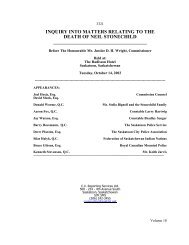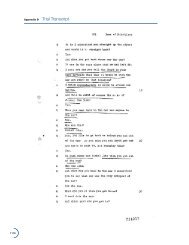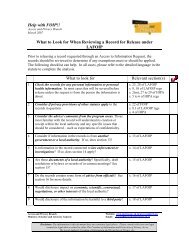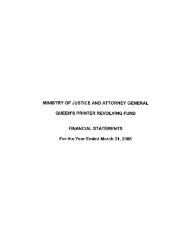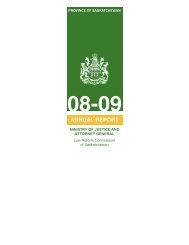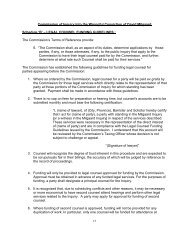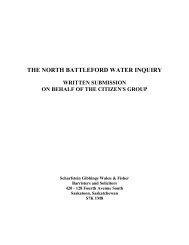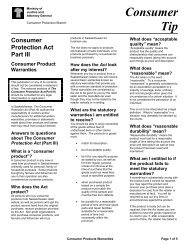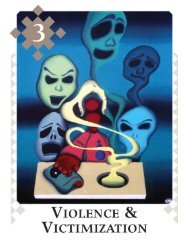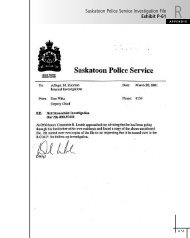Appendix K Memorandum of Law - s. 9(2) of the Canada Evidence Act
Appendix K Memorandum of Law - s. 9(2) of the Canada Evidence Act
Appendix K Memorandum of Law - s. 9(2) of the Canada Evidence Act
You also want an ePaper? Increase the reach of your titles
YUMPU automatically turns print PDFs into web optimized ePapers that Google loves.
<strong>Appendix</strong> K <strong>Memorandum</strong> <strong>of</strong> <strong>Law</strong><br />
(a) Evidentiary Value <strong>of</strong> Inconsistent Statements Proved Under Section 9(1) <strong>of</strong> <strong>the</strong> CEA<br />
(b) Evidentiary Value <strong>of</strong> Inconsistent Statements Proved Under Section 9(2) <strong>of</strong> <strong>the</strong> CEA<br />
(8) What Constitutes an “Inconsistency” under Section 9(2) <strong>of</strong> <strong>the</strong> CEA?<br />
III. CONCLUSION<br />
Historical Lineage and Purpose <strong>of</strong> Sections 9(1) and (2) <strong>of</strong> <strong>the</strong> CEA<br />
The origins <strong>of</strong> s. 9 <strong>of</strong> <strong>the</strong> CEA can be traced back to 19th century England and a widely debated point at<br />
common law: whe<strong>the</strong>r, and under what circumstances, a party could use a prior inconsistent statement to<br />
discredit his own witness.<br />
At common law, if a party’s witness admitted making an inconsistent statement, <strong>the</strong> party could<br />
cross‐examine that witness with respect to why he contradicted his earlier statement. However, when a<br />
witness denied making <strong>the</strong> previous statement, <strong>the</strong> party’s ability to introduce, prove and cross-examine<br />
<strong>the</strong> witness on <strong>the</strong> inconsistent statement became uncertain. To resolve <strong>the</strong> uncertainty, Parliament<br />
enacted s. 22 <strong>of</strong> <strong>the</strong> Common <strong>Law</strong> Procedure <strong>Act</strong> (1854) and s. 3 <strong>of</strong> <strong>the</strong> Criminal Procedure <strong>Act</strong> (1865),<br />
which allowed a party to cross-examine his or her own witness on a prior inconsistent statement upon<br />
pro<strong>of</strong> that <strong>the</strong> witness was ‘adverse’. These provisions were subsequently adopted in substantially similar<br />
form in a number <strong>of</strong> jurisdictions, including <strong>Canada</strong>, its provinces and Australia. In <strong>Canada</strong>, <strong>the</strong> English<br />
provisions now exist in <strong>the</strong> form <strong>of</strong> s. 9(1) <strong>of</strong> <strong>the</strong> CEA.<br />
The first case to consider s. 22 <strong>of</strong> <strong>the</strong> Common <strong>Law</strong> Procedure <strong>Act</strong>, <strong>the</strong> English predecessor to s. 9(1) <strong>of</strong><br />
<strong>the</strong> CEA, was Greenough v. Eccles 1 . Greenough v. Eccles which held that a party was not allowed to use<br />
a prior inconsistent statement to demonstrate <strong>the</strong> adversity <strong>of</strong> <strong>the</strong>ir witness. The overall result <strong>of</strong> <strong>the</strong> ruling<br />
in Greenough v. Eccles was <strong>the</strong> creation <strong>of</strong> a procedural ‘catch-22’, since a party calling a witness might<br />
need to use a prior inconsistent statement to prove that <strong>the</strong>ir witness was adverse, but was prohibited<br />
from relying on <strong>the</strong> prior statement until adversity was proven by o<strong>the</strong>r means.<br />
Early Canadian decisions like R. v. May 2 followed <strong>the</strong> precedent set by Greenough v. Eccles. However,<br />
many courts in <strong>the</strong> Commonwealth recognized <strong>the</strong> conundrum created by Greenough v. Eccles and<br />
began interpreting <strong>the</strong> provision in a manner that would remedy <strong>the</strong> procedural ‘catch-22’. Three <strong>of</strong><br />
those cases were Hannigan 3 , Hunter 4 , and Wawanesa (OCA) 5 . Those cases held that a party producing<br />
a witness was entitled to rely on a prior inconsistent statement to prove ‘adversity’ under statutory<br />
counterparts to s. 9(1) <strong>of</strong> <strong>the</strong> CEA provided that <strong>the</strong> inconsistent statement was put to <strong>the</strong> witness in a<br />
voir dire in absence <strong>of</strong> <strong>the</strong> jury.<br />
By 1968 Parliament recognized <strong>the</strong> divergence in <strong>the</strong> jurisprudence under s. 9(1) <strong>of</strong> <strong>the</strong> CEA and<br />
introduced an amendment to resolve <strong>the</strong> conflict respecting its operation. That amendment, which now<br />
exists in <strong>the</strong> form <strong>of</strong> s. 9(2) <strong>of</strong> <strong>the</strong> CEA, came into force on February 13, 1969. Parliamentary statements<br />
prior to <strong>the</strong> enactment <strong>of</strong> s. 9(2) <strong>of</strong> <strong>the</strong> CEA clearly indicate that s. 9(2) <strong>of</strong> <strong>the</strong> CEA was a reformatory<br />
enactment designed to work in unison with and resolve <strong>the</strong> procedural ‘catch-22’ respecting <strong>the</strong><br />
1 Infra note 24. Greenough v. Eccles was decided in 1859.<br />
2 Infra note 27. R. v. May was decided by <strong>the</strong> British Columbia Court <strong>of</strong> Appeal in 1915.<br />
3 Infra note 29. Hannigan was decided by <strong>the</strong> Irish Criminal Court <strong>of</strong> Appeal in 1941.<br />
4 Infra note 30. Hunter was decided by <strong>the</strong> Supreme Court <strong>of</strong> Victoria in Australia in 1956.<br />
5 Infra note 21. Wawanesa (OCA) was decided by <strong>the</strong> Ontario Court <strong>of</strong> Appeal in 1963.<br />
2574



